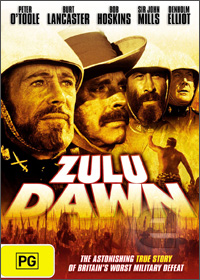Nel 1879 gli inglesi sottovalutarono la forza e l'intelligenza tattica dei guerrieri zulù comandati da Cetedeve, re del Natal. Lo scontro fu terribile e culminò nella battaglia di Isandhlwana con una strage. Impietosa descrizione dello smacco che effettivamente umiliò la Gran Bretagna, ricostruito con notevoli mezzi da Hickox. I personaggi sono scoloriti, la drammaturgia è primitiva, i dialoghi radiofonici.
- - -
The film is set in British South Africa, in the province of Natal, in January 1879. The first half of the film revolves around the administrators and officials of Cape Colony, notably the supremely arrogant Lord Chelmsford and the scheming Sir Henry Bartle Frere, who both wish to crush the neighbouring Zulu Empire, perceived as a threat to Cape Colony's emerging industrial economy. Eager to crush the Zulus, Bartle Frere issues an impossible ultimatum to the Zulu king, Cetshwayo, demanding that he dissolves the Zulu Empire. Cetshwayo refuses, providing Cape Colony with a pretext to invade Zululand. Despite objections from leading members of Cape Colony's high society and from Great Britain itself, Bartle Frere authorises Lord Chelmsford to lead a British invasion force into Zululand.
The second half of the film focuses on the British invasion of Zululand and the lead-up to the Battle of Isandhlwana. The invading British army, laden down with an immense network of supply wagons, invades Zululand and marches in the direction of Ulundi, the Zulu capital. British forces, eager to fight a large battle in which they can unleash their cutting-edge military technology against the vast Zulu army, become increasingly frustrated as the main Zulu army refuses to attack the British, and fighting is restricted to a few small skirmishes between British and Zulu scouts. Concerned that their supply lines are becoming overstretched and that the main Zulu army is still at large, British troops begin torturing captive Zulu warriors in an effort to learn the location and tactics of the Zulu field army. Halfway to Ulundi, Chelmsford halts his army at the base of Mount Isandhlwana, ignoring the advice of Boer attendants to entrench the camp and laager his supply wagons, leaving the camp dangerously exposed. In the night Colonel Durnford and an escort of fifty mounted Basutos approach the camp. Lord Chelmsford then orders Durnford, to return to his unit, bringing them to the camp immediately to reinforce Colonel Pulleine. Lt. Vereker should join Durnford as aide-de-camp. Reacting to false intelligence, Chelmsford leads half of the British army, including the best infantry, cavalry, and artillery units, on a wild goose chase far from the camp, in pursuit of a phantom Zulu army. On the day of battle, Durnford and his troops are arriving at 11:00 a.m. at the camp at Isandlwana. Meanwhile the Zulu captives escape their torturers and regroup with the Zulu army, informing them of the British army's direction and strength. After having lunch with Colonel Pulleine and Lt. Vereker, Durnford quickly decides, to send out Vereker to scout the hills. Durnford then decides to take his own command out from the camp too, and scout the iNyoni heights.
The entire Zulu army is later discovered by men of Lt. Vereker’s troop of scouts, who chase a number of Zulu herdsmen, trying to hurry away their cattle, only then seeing the main Zulu enemy force of thousands of Zulus, looking up at them in surprise, sitting in the bottom of a valley. Lt. Vereker then sends Lt. Raw to warn the camp that it was about to be attacked.
As Zulu impis descend upon the camp, Durnford's cavalry retreat to a donga in an effort to hold back the Zulu advance. Forced back, the British take heavy casualties, including the battery of Congreve rockets, which is overrun by the Zulus. Initially, the British infantry succeed in defending the camp, and Zulu forces retreat under a hail of rifle and artillery fire. However, British units defending the camp are dangerously spread-out, and do not notice Zulu forces moving round the sides of the mountain in an encircling move. As British infantrymen begin to run out of ammunition and the British cavalry are driven back towards the camp, Zulu warriors charge the British troops en masse, sustaining horrific casualties, but succeed in breaking the British lines. As British troops break and flee towards the camp, the battle breaks down into hand-to-hand fighting between British soldiers and Zulu warriors, amongst the débris of tents, wagons, and supply dumps. Overwhelmed by the sheer numbers of Zulu warriors, British soldiers and their African allies are slaughtered in the camp, or cut down as they attempt to flee back towards Natal. During the last minutes of the battle, the camp's commander, Colonel Pulleine, entrusts the Union Jack to two junior officers, Lieutenants Melvill and Coghill, who attempt to carry it to safety in Natal, passing gruesome scenes as Zulu warriors hunt down British and African infantrymen attempting to flee towards Natal. While attempting to cross the Buffalo River, the three lieutenants - Melvill, Coghill, and Vereker - are cut down by Zulus and the Union Jack is captured. However, a final shot by one of the Lieutenants kills the Zulu holding the Colours and the Colours are saved from capture as they fall into the river. In the evening, Chelmsford and the rest of the British army return to Isandhlwana, to be greeted by the sight of their slaughtered comrades, and the news that a mass Zulu army has invaded Natal and lain siege to Rorke's Drift. The film ends with Zulu warriors in a silhouetted victory procession, dragging captured British artillery back to Ulundi. |
